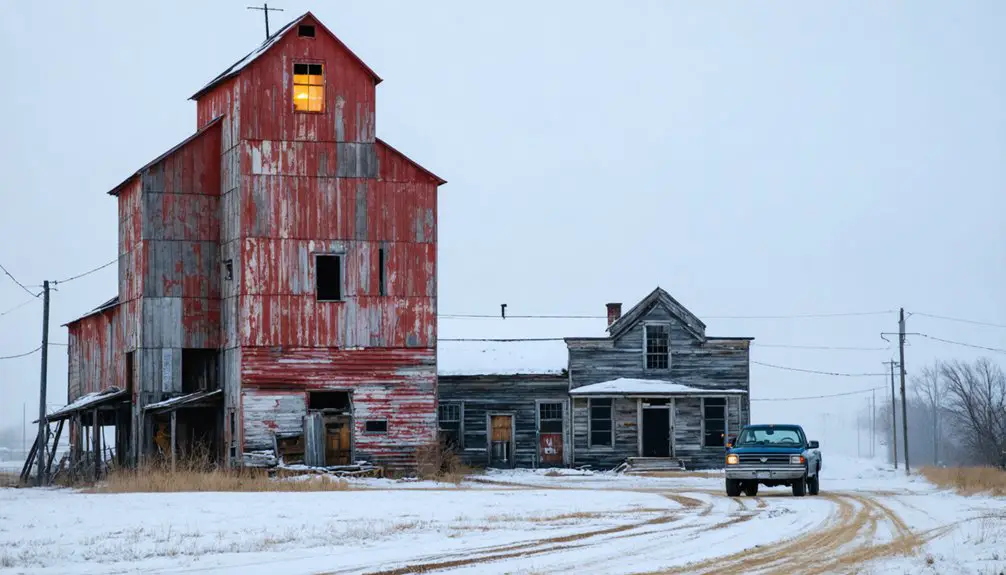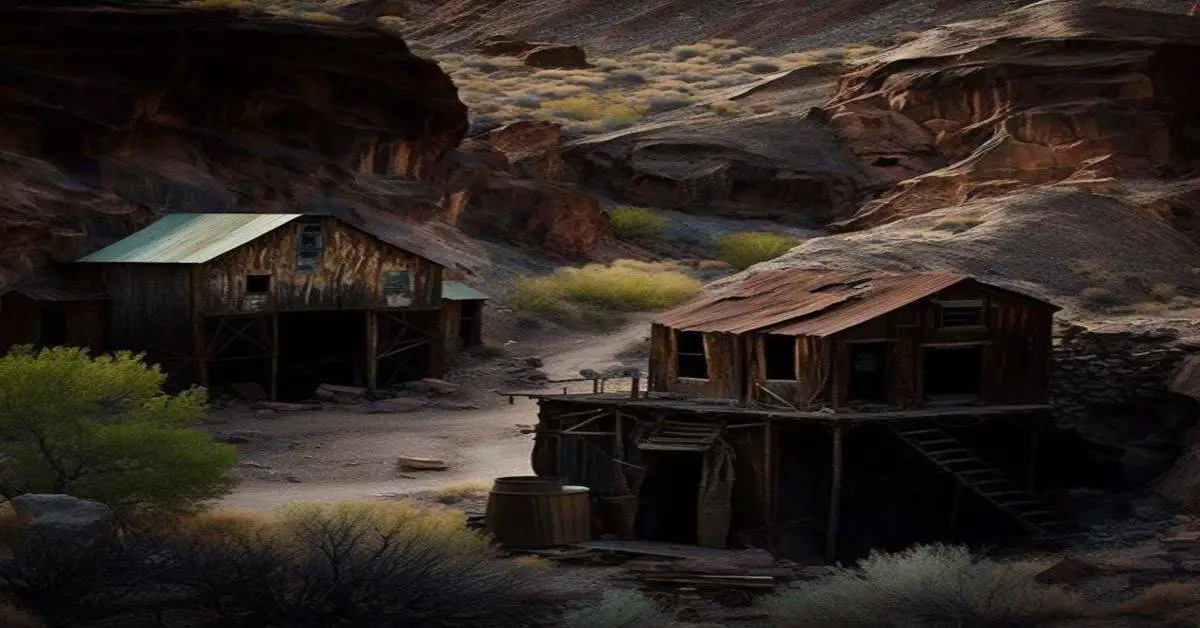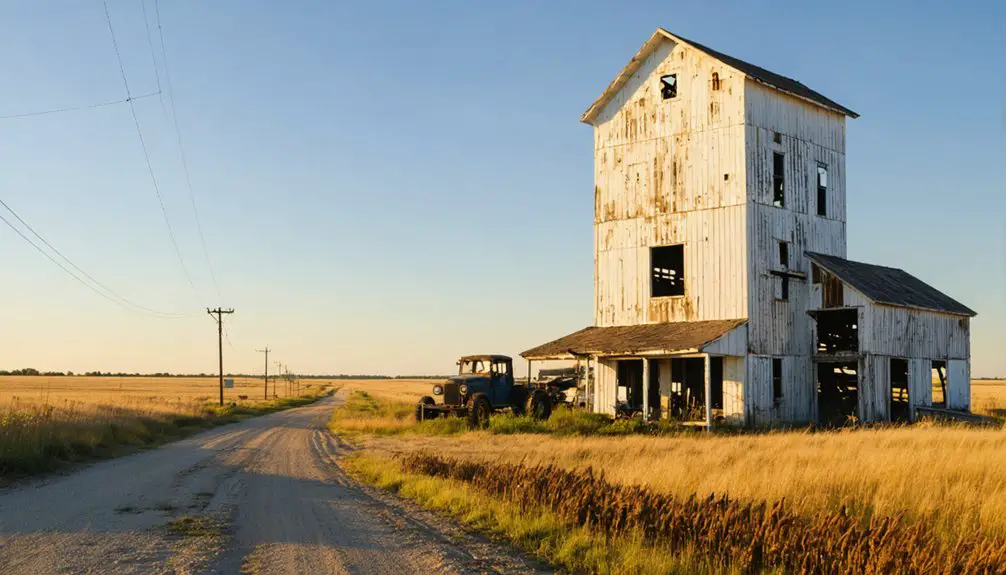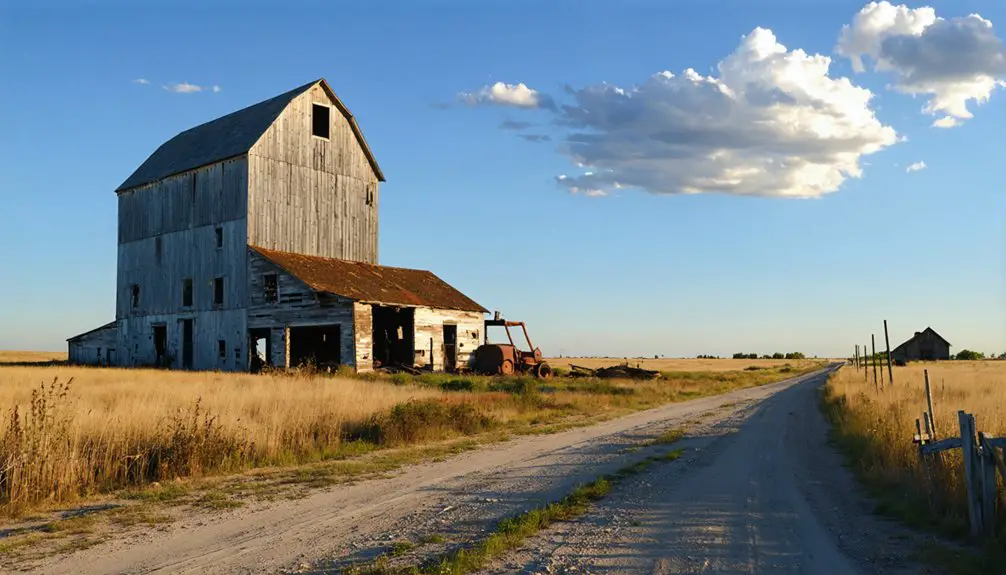You’ll find Alfred, North Dakota as a near-ghost town with deep English roots, founded by entrepreneur Richard Sykes in LaMoure County. While its population peaked at 150 in 1930, today only a handful of residents remain. The town’s resilient spirit lives on through its Seventh Day Adventist Church, cemetery, and abandoned structures that dot the landscape. Alfred’s rich agricultural heritage and pioneering story holds countless tales of determination and community bonds.
Key Takeaways
- Alfred, North Dakota was founded by English entrepreneur Richard Sykes and reached its peak population of 150 residents in 1930.
- The removal of the railroad line significantly contributed to Alfred’s decline into a near-ghost town status.
- The Seventh Day Adventist Church remains active with a maintained cemetery, while most other structures are abandoned.
- Few residents remain in Alfred today, commuting to nearby communities for work and essential services.
- Original structures include abandoned homes and a small one-room building, serving as historical remnants of the town’s past.
The English Roots of Alfred’s Foundation
While many North Dakota towns sprouted from the railroad’s westward expansion, Alfred’s story began with the vision of English entrepreneur Richard Sykes. As one of five towns he established in North Dakota, Alfred embodied his strategy of creating agricultural communities that would attract settlers from the United Kingdom.
You’ll find strong English influence woven into Alfred’s early development, from its architectural elements to its community planning. The settlement patterns reflected Sykes’ broader vision of transplanting British rural traditions to the North Dakota prairie. Residents would sometimes gather to enjoy masque performances, reminiscent of Thomas Arne’s 18th-century theatrical works.
English settlers brought their familiar farming practices, though they’d soon learn to adapt to the challenging subhumid grasslands. The town reached its peak with 150 permanent residents in 1930. As a prominent landowner, Sykes shaped Alfred’s character through calculated land sales and infrastructure investments, creating a distinctly English outpost on the American frontier.
Peak Years and Early Settlement
Richard Sykes’ English vision took root as Alfred steadily grew into a vibrant agricultural community in LaMoure County. The settlement patterns reflected the determined spirit of early pioneers who established homes, a grocery store, and a licensed boarding house near the small lake southwest of Jamestown.
Like early frontier towns along railroad lines, Alfred adapted to the transportation needs of the era. As agricultural practices evolved around grain farming, the town’s infrastructure expanded to support the growing community. You’d have found grain storage bins, a post office, and a rail line that connected Alfred to broader markets.
The Railway’s Rise and Removal
As the Northern Pacific and Great Northern railroads expanded across Dakota Territory in the 1870s and 1880s, Alfred’s strategic location positioned it to benefit from this transportation revolution.
You would’ve witnessed railroad construction advancing at an impressive 3.5 miles per day, transforming the landscape and settlement patterns around you.
The railroad’s impact on Alfred was profound, connecting the town to broader markets and bringing waves of settlers, many recruited from Europe by the Great Northern’s agencies.
German-Russian settlers became a dominant cultural force in the region, establishing thriving agricultural communities along the rail lines.
However, the town’s fortunes changed dramatically when the rail line was eventually removed. The town faced challenges similar to those during the hard times of 1930s when numerous North Dakota communities struggled to survive.
You can still see the effects today in Alfred’s northeast section, where abandoned structures stand as silent reminders of the town’s former liveliness.
Like many North Dakota communities, Alfred’s story illustrates how railroad access could make or break a town’s future.
Surviving Buildings and Landmarks
As you explore Alfred’s quiet streets today, you’ll find the well-maintained Seventh Day Adventist Church standing as a symbol of the community’s enduring faith and resilience.
The church’s active congregation maintains both the building and the adjacent cemetery, preserving these sacred spaces as living connections to Alfred’s heritage.
Beyond these religious landmarks, you can spot several abandoned homes and structures, including a small one-room building with wooden interior walls and a full-size house with its original living room and kitchen features still intact. Economic pressures led to the farming consolidation that transformed the rural landscape.
Like many other North Dakota towns that peaked between 1920 and WWII, Alfred experienced a gradual population decline as residents moved to larger centers offering modern amenities.
Church and Cemetery Highlights
Two significant landmarks stand as proof to Alfred’s enduring spirit – the active Seventh Day Adventist Church and the well-maintained Alfred Cemetery.
The church’s significance extends beyond its walls, drawing worshippers from surrounding areas with about ten vehicles regularly attending services, making it the most consistently used structure in town. Originally founded by Richard Sykes, an Englishman, the town has maintained its religious presence despite significant population decline.
The cemetery symbolism speaks volumes about Alfred’s heritage, preserving the stories of early settlers and families through well-kept headstones and markers. With 91% photographed memorials, the cemetery provides extensive documentation of those who shaped the community’s history.
These two landmarks, often found together in rural North Dakota communities, continue to anchor local identity despite widespread abandonment.
You’ll find them serving as evidence to the town’s cultural persistence, with the church’s active congregation potentially contributing to the cemetery’s impressive upkeep and historical preservation.
Notable Standing Structures
While many of Alfred’s original structures have succumbed to time, several residential buildings remain as silent witnesses to the town’s past.
You’ll find a full-size abandoned home partially hidden by trees, where you can still glimpse its living room and kitchen through weathered walls. A small one-room structure stands near an intact garage, both defying decades of exposure to the elements. Much like the buildings left by Government at Fort Ransom, many of Alfred’s abandoned structures were taken by early settlers.
The town’s commercial heart has largely vanished, with no remaining businesses, rail depots, or public buildings.
Even the railroad tracks that once brought life to Alfred’s northeast section have been removed.
Today, beyond the church, you’ll mainly see residential structures – homes with exposed basement access holes and aging garages that tell the story of typical small-town life through their varying states of structural integrity.
Modern Life in a Near-Ghost Town

You’ll find Alfred’s few remaining residents maintaining daily routines despite the town’s near-ghost status, as they commute to nearby communities for work and basic necessities while adapting to life with minimal local infrastructure.
The strong bonds between neighbors persist through informal gatherings and mutual support, even as traditional community institutions have faded away.
Your visit to Alfred today reveals a demonstration of rural resilience, where residents balance their desire for solitude with the practical challenges of accessing modern services and maintaining connections to the wider world.
Daily Routines Persist
Life in Alfred continues with a quiet resilience, as the remaining residents maintain their daily rhythms despite the town’s diminished population.
You’ll find farmers tending their crops and livestock at dawn, carrying out daily chores that haven’t changed for generations. While the town’s footprint has shrunk, the post office and local café serve as crucial community gathering spots where neighbors exchange news and support.
You’ll notice how residents have adapted to the town’s smaller scale, making regular trips to nearby communities for supplies while maintaining their independence through self-sufficiency.
They’ve preserved essential routines, from household maintenance to seasonal agricultural tasks, proving that even with limited services and an aging population, the spirit of rural life endures in this near-ghost town.
Community Spirit Endures
The heartbeat of Alfred’s community spirit refuses to fade, even as the town’s physical presence diminishes.
You’ll find residents gathering regularly for seasonal festivals and volunteer events that keep their heritage alive, while local sports and recreational activities provide essential social connections in this close-knit community.
Through shared transportation arrangements and informal support networks, you’ll witness how neighbors help each other overcome the challenges of rural isolation.
The town’s cultural identity thrives in its small museum, where residents preserve their stories through oral histories and artifacts.
Local clubs celebrate founding events and honor notable past residents, while community gatherings in preserved halls and churches strengthen the bonds between families who’ve chosen to maintain Alfred’s legacy despite its ghost town status.
Religious and Cultural Heritage
Standing as a demonstration to enduring faith, Alfred’s religious heritage centers around its active Seventh Day Adventist Church, which continues to draw worshippers despite the town’s dwindling population.
Alfred’s Seventh Day Adventist Church stands strong, keeping faith alive even as the town’s numbers fade away.
The religious practices established by founder Richard Sykes and early settlers have shaped the cultural significance of this resilient community.
You’ll find Alfred’s spiritual legacy preserved through:
- A well-maintained cemetery reflecting Protestant traditions
- Regular church services drawing attendees from surrounding areas
- Community gatherings centered around religious observances
- Cultural traditions passed down through generations
- Religious architecture that stands as a symbol of the town’s English roots
While many North Dakota ghost towns have lost their spiritual centers, Alfred’s church remains a beacon of community life, preserving both faith and cultural identity for those who call this region home.
Preserving Alfred’s Historical Legacy

While many ghost towns fade into obscurity, Alfred’s historical legacy endures through dedicated preservation efforts by its remaining residents and supporters.
You’ll find Alfred’s historical significance reflected in its well-maintained cemetery, operational Seventh Day Adventist Church, and several intact historic structures that tell the story of this once-thriving community.
Current preservation strategies combine formal and informal approaches.
You can see this through the continued use of buildings like the licensed boarding home and grocery store, which serve modern needs while maintaining their historic character.
The surrounding farmland and lake preserve the town’s agricultural heritage, while photographic documentation and local histories guarantee Alfred’s story lives on.
Regular religious gatherings and community activities help keep the town’s cultural traditions alive despite its unincorporated status.
Frequently Asked Questions
What Was the Average Property Value in Alfred During Its Peak Years?
You’d be amazed that property values were surprisingly modest – likely between $500-$3000 during Alfred’s 1930s peak, as economic factors and rural property trends shaped this tight-knit farming community’s real estate market.
Did Alfred Ever Have Its Own School System?
You’ll find the school history in Alfred remains uncertain, though it likely had a small one-room schoolhouse during its peak years before education impact led to consolidation with nearby districts.
What Industries Besides Agriculture Existed in Alfred’s Early Days?
Like a prairie sentinel, you’d find basic merchant shops serving local needs, but there weren’t any major mining operations or transportation hubs – just small-scale commerce supporting the farming community.
Were There Any Notable Crimes or Significant Incidents in Alfred’s History?
You won’t find records of ghostly encounters or historical crimes in the archives. The town’s story centers on peaceful decline and community life rather than notable incidents or violence.
How Many Original Pioneer Families’ Descendants Still Live in Alfred Today?
Like tracing footprints in shifting sand, you can’t pinpoint the exact number of pioneer lineage descendants in today’s Alfred. Available records don’t track this family heritage through generations.
References
- https://ghostsofnorthdakota892857007.wordpress.com/2012/07/10/alfred-nd/
- https://news.prairiepublic.org/show/dakota-datebook-archive/2022-06-10/sully-springs-a-badlands-ghost-town
- https://en.wikipedia.org/wiki/Alfred
- https://ghostsofnorthdakota892857007.wordpress.com/category/alfred-nd/
- https://news.prairiepublic.org/show/dakota-datebook-archive/2022-04-25/100-years-of-gackle-and-alfred
- https://commons.und.edu/context/oers/article/1000/viewcontent/History_of_ND_FinalPDF.pdf
- https://en.wikipedia.org/wiki/Battle_of_Killdeer_Mountain
- https://schs.omeka.net/items/show/4644
- https://uk.pinterest.com/pin/270286415113624470/
- https://writinforthebrand.com/the-railroad-and-settlement-in-early-north-dakota/



